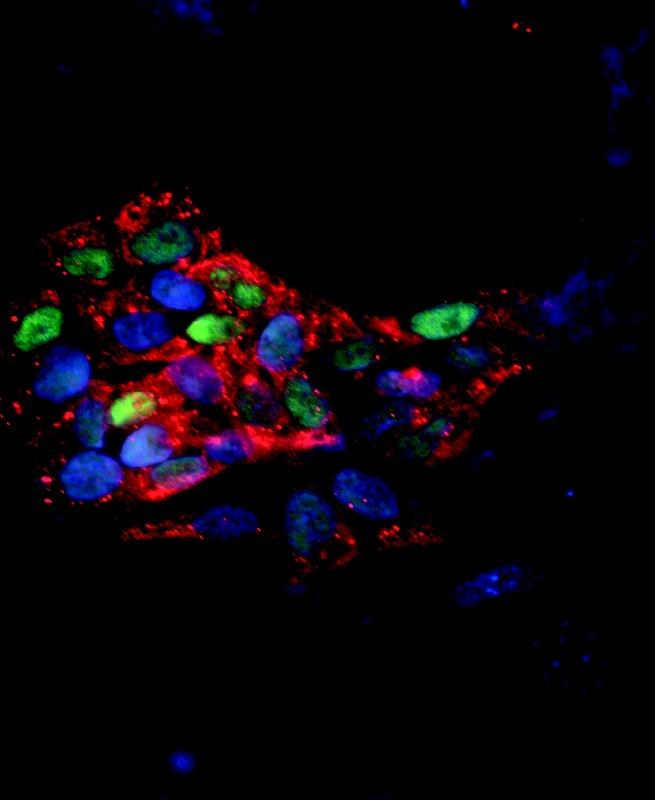

Human induced pluripotent stem cell colony expressing endogenous LINE-1 proteins (red) which lead to the mobilization of transposable elements in the stem cell genome. Cell nuclei are cyan stained.
Klawitter S et al.: Nature Communications
Human induced pluripotent stem cells (hiPSCs) hold substantial promise for biomedical applications because they have the potential to give rise to every cell type of the human body. Amongst other applications, hiPSCs have the potential to be applied in regenerative medicine for autologous cell therapies.
To this end, patients’ somatic cells are reprogrammed into hiPSCs, differentiated into the favored, therapeutically relevant cell type, and finally administered to the patient. However, during reprogramming and hiPSC cultivation, genetic and epigenetic aberrations occur.
The scientists uncovered that mobilization and resulting new insertions of endogenous jumping genes occurred in the genomes of 4 out of 8 analyzed hiPSC lines both during reprogramming and subsequent hiPSC cultivation.
Mobilization of jumping genes occurred at a frequency of ~1 retrotransposition event per hiPSC. Mobilization of preexisting endogenous L1 elements also generated new functional L1 copies which again are able to spread throughout the genome and give rise to new gene mutations. Jumping of endogenous transposable elements causes new, potentially mutagenic insertions that can influence the function of the host cell and participate in the process of transformation to a tumor cell.
“Genomic integrity of pluripotent stem cells can be impaired by the mobilization of endogenous transposable elements which is mediated by endogenous L1 activity. This raises the question to what extent the safety of cellular therapies is affected if differentiated cells derived from such hiPSCs are applied”, said Dr Schumann explaining the significance of their findings.
The research group will address these questions as a next step. From a regulatory point of view, testing the safety of these cells before they are applied in a potentially therapeutic setting would reduce the risk associated with these cells.
Background – Induced pluripotent stem cells in Biomedicine
Human induced pluripotent stem cells (hiPSCs) hold substantial promise for regenerative medicine. hiPSCs are capable of unlimited proliferation and can differentiate in vitro to generate derivatives of the three primary germ layers. hiPSC applications include disease modeling, study of cell development and function, in vitro screening of drug candidates on healthy and diseased cells. hiPSCs are a cell source of potential future substitutive and regenerative autologous cell therapies where patient cells are reprogrammed to pluripotent stem cells and subsequently differentiated into the favoured therapeutic cell type. Unlike organ transplants and human embryonic stem cells, hiPSCs are a source of autologous cells compatible with the immune system of transplant recipients.
Original Publication:
Klawitter S, Fuchs NV, Upton KR, Muñoz-Lopez M, Shukla R, Wang J, Garcia-Canadas M, Lopez-Ruiz C, Gerhardt DJ, Sebe A, Grabundzija I, Merkert S, Gerdes P, Pulgarin JA, Bock A, Held U, Witthuhn A, Haase A, Sarkadi B, Löwer J, Wolvetang EJ, Martin U, Ivics Z, Izsvák Z, Garcia-Perez JL, Faulkner GJ, Schumann GG (2015). Reprogramming triggers endogenous L1 and Alu retrotransposition in human induced pluripotent stem cells. Nat Commun 7, Article number: 10286
doi:10.1038/ncomms10286
The Paul-Ehrlich-Institut, Federal Institute for Vaccines and Biomedicines in Langen near Frankfurt/Main, is a senior federal authority reporting to the Federal Ministry of Health (Bundesministerium für Gesundheit, BMG). It is responsible for the research, assessment, and marketing authorisation of biomedicines for human use and veterinary vaccines. Its remit also includes the authorisation of clinical trials and pharmacovigilance, i.e. recording and evaluation of potential adverse effects. Other duties of the institute include official batch control, scientific advice and inspections. In-house experimental research in the field of biomedicines and life science form an indispensable basis for the varied and many tasks performed at the institute. The PEI, with its roughly 800 staff, also has advisory functions at a national level (federal government, federal states (Länder)), and at an international level (World Health Organisation, European Medicines Agency, European Commission, Council of Europe etc.).
http://www.nature.com/ncomms/2016/160108/ncomms10286/full/ncomms10286.html – Abstract of the Publication
http://www.pei.de/EN/information/journalists-press/press-releases/2016/01-mobili… – This Press Release on the Paul-Ehrlich-Institut Website












